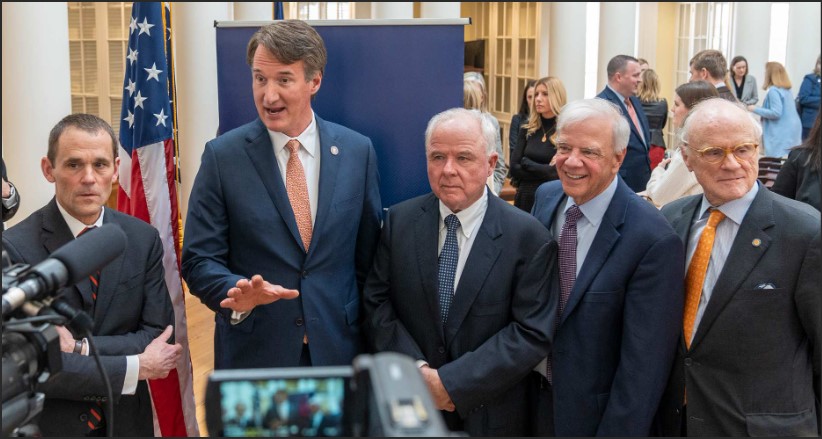
From left, UVa President Jim Ryan, Governor Glenn Youngkin, Paul Manning, UVA Health CEO Dr. K. Craig Kent and University Rector Whitt Clement. Photo credit: UVA Today
by James A. Bacon
Entrepreneur-philanthropist Paul Manning and his wife Diane have donated $100 million to create a biotechnology institute that will focus on cellular therapy, gene therapy, nanotechnology and drug delivery to counter diseases that have so far eluded treatment. In making the announcement Friday, Virginia officials say the new institute could become an important economic driver for Virginia, attracting biotech and pharmaceutical companies to the state and potentially generating thousands of direct and indirect jobs.
The Mannings’ gift will be matched by a $50 million investment from the Commonwealth of Virginia and $150 million from the University of Virginia itself, according to UVA Today.
“We live in an incredibly exciting time of discovery in medicine – and the Manning Institute will ensure UVA remains at the forefront of research and patient care,” UVa President Jim Ryan said. “Paul and Diane Manning’s extraordinary gift will mean new treatments and therapies for the patients who need them most, and I’m immensely grateful for their generosity and vision.”
Ryan also thanked Governor Glenn Youngkin and the General Assembly for the state’s financial support.
“This major investment will help attract pharmaceutical companies to the commonwealth and further my administration’s commitment to develop a thriving health care system,” Youngkin said.
The creation of the Paul and Diane Manning Institute of Biotechnology will give a big boost to UVa’s ambitions to become an R&D powerhouse. In 2021 UVa generated $611 million in R&D expenditures, putting it ahead of state rival Virginia Tech at $542 million.
Still, UVa is a second-tier player in the R&D game, ranking 48th nationally in R&D spending, far behind national leader Johns Hopkins University ($3.2 billion) and the top public university, the University of Michigan ($1.6 billion). UVa’s strength as a research university is owed mainly to its medical school and related biosciences.
While UVa has been graduating more STEM (Science, Technology, Engineering and Medicine) degrees in recent years, the percentage of STEM degrees has not changed significantly over the past three decades because enrollment in non-STEM degrees has been increasing as well.

Source: State Council of Higher Education for Virginia
In 1991, STEM degrees comprised 31.4% of all degrees granted at UVa, according to State Council of Higher Education for Virginia (SCHEV) data. In 2021-22 the percentage stood at 33.6%.



